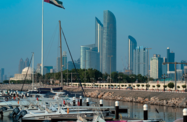In 2011 Abu Dhabi made significant progress towards its long-term goal of economic diversification, with major developments in the fields of industry, transport and tourism. While these are significant accomplishments, the government announced in late 2011 that it was reprioritising certain projects.
The year started well, with local industrialists welcoming news that the Shah natural gas project was back on track following the signing of a deal with a new foreign partner. On January 20, 2011, Occidental Petroleum and the Abu Dhabi National Oil Company announced that they would jointly develop the Shah sour gas field. The project is expected to cost around $10bn and the target date for completion is 2014. The field could yield 28.3m cu metres of gas per day.
Despite its substantial gas reserves, Abu Dhabi is currently a net importer of gas, which is used mainly for producing power and desalinated water. However, a large share of future electricity demand is expected to come from the emirate’s burgeoning industrial sector, in which the government has invested heavily as part of its long-term push for economic diversification.
By far the biggest planned industrial project is the Khalifa Industrial Zone Abu Dhabi (KIZAD), a 417-sq-km zone that will target basic industries in aluminium, steel, glass and paper. KIZAD is promoting itself as a one-stop shop to attract global industrial companies, a strategy that is allowing local joint venture businesses and international firms to trade at the zone.
In mid-December, for example, Khaled Salmeen, the executive vice-president of the Abu Dhabi Port Company (ADPC), announced that 30 industrial projects valued at $5bn would be built at the zone within two to three years. KIZAD is already home to anchor tenant Emirates Aluminium (EMAL), which was formed in 2007 as a joint venture between Dubai Aluminium and Mubadala Development Company, a government-owned investor. The first phase of the project came on-line in 2009 and was formally inaugurated in April 2011. In July the company announced plans for a $4.5bn expansion programme that would increase production capacity from 750,000 metric tonnes per annum (mtpa) to 1.3m mtpa by the end of 2014. EMAL is set to be the largest industrial project in the UAE outside the oil and gas sector, and currently employs some 2000 people.
Companies that locate at KIZAD will benefit from multi-modal transport links, not just with the adjacent port facilities that are being developed, but also with rail lines provided by the Etihad Rail project, which is due for completion in 2017. In November, Richard Bowker, the CEO of Etihad Rail – the state-owned company tasked with developing the UAE’s mainline rail network – announced it would soon call for tenders for the second stage of the $11bn project Work on the first phase of the project, which is on-going, will connect the cities of Habshan, Shah and Ruwais in the emirate’s Western Region. The second phase will involve constructing the rest of the line through Abu Dhabi, linking with logistics centres in and around the capital, as well as an extension of the network to Dubai.
While development of an industrial base is an important component in the emirate’s economic diversification plans, tourism is also expected to play an important role in reducing dependence on the hydrocarbons sector. Positive news about this sector emerged in late 2011, with Lawrence Franklin, the strategy and policy director of the Abu Dhabi Tourism Authority (ADTA), telling local media in November that the organisation was “quite optimistic about reaching [its] 2011 target of 2m hotel guests”. Franklin added that numbers were strong in October and the authority expected good results for November, thanks to the Formula 1 Etihad Airways Abu Dhabi Grand Prix, an event that the emirate has hosted since 2009.
The government has invested heavily in the tourism sector over the last five years. However, it appears to be slowing the pace of development, with the Tourism Development and Investment Company (TDIC), a government-owned entity, announcing in October that it was delaying the opening of three museums originally scheduled to launch between 2013 and 2014.
The three museums – Abu Dhabi branches of the Louvre and Guggenheim, as well as the Zayed National Museum – will eventually be part of the $27bn Saadiyat Island development, slated to be the emirate’s culture centre and a major draw for tourists. TDIC said in a statement that it had “decided to extend the delivery dates” in light of “the immense magnitude of the work associated with the development of such consequential projects”.
With a somewhat bleak outlook for the global economy in the final months of 2011, the decision by Abu Dhabi’s government to retrench is not surprising. However, in other sectors positive local developments did emerge late in the year, including the UAE Cabinet’s approval in December of a new draft Commercial Companies Law (CCL), which had been under discussion for some time.
The new law will reduce start-up costs for firms by removing the minimum capital requirement of Dh150,000 ($40,838), which will make it easier for businesses, particularly smaller enterprises, to be established. It may also ease the way for new foreign investment legislation, with the draft CCL stating that the Cabinet can issue a separate resolution regarding the type of businesses that can be majority-owned by foreigners. At present, for businesses located outside the emirate’s free trade zones, foreigners are limited to a 49% stake, which can be a concern for investors. Any relaxation of this restriction would be warmly received by foreign businesses.
Looking ahead, the year 2012 may be a soft-landing for the emirate, following a period of rapid expansion that began in the wake of the global economic crisis. Nonetheless, while the government may be re-reprioritising some of its investments, developments such as the new CCL law and the continued build-up of transportation and industrial infrastructure could provide opportunities for the private sector to flourish.

